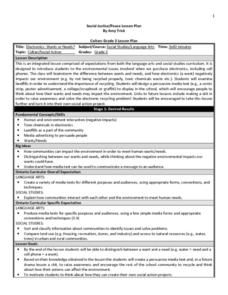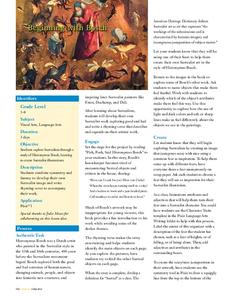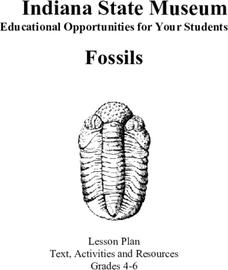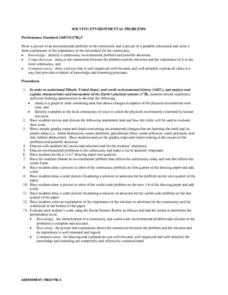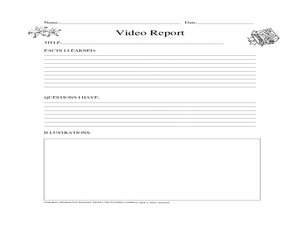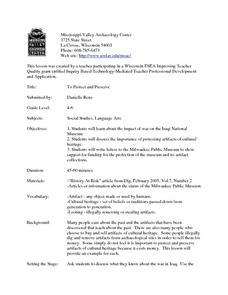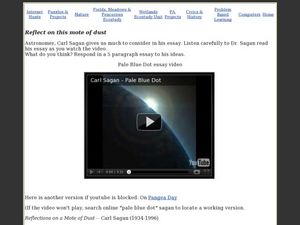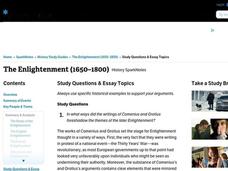Curated OER
What's Missing?
Learners examine their beliefs about archaeological preservation. They articulate a response to archaeological resource destruction. Students then complete two puzzles and relate them to archaeological research.
Curated OER
Electronics: Wants or Needs?
Third graders determine how electronics negatively impact the environment. In this environmental activity, 3rd graders read the article "Earth Friendly Waste Management", and identify how recycling impacts our environment. Students...
Curated OER
Beginning with Bosch
Students become familiar with surrealism through the artwork of Hieronymus Bosch. In this Bosch lesson, students explore symmetry and surrealism. Students create step by drawings on the computer in the style of Hieronymus Bosch. Students...
Curated OER
The Space Cadet's Laboratory: Using Electromagnetic Energy to Study Astronomy
Young scholars build their own spectrophotometer to study light. In this physics lesson, students explain the dual nature of light. They calculate the angle of incidence and refraction using Snell's law equation.
Curated OER
Fossils
Students complete a unit on fossils. They read and discuss informational handouts, define key vocabulary terms, answer discussion questions, create a geologic timeline and a timeline of their own life, analyze bones, and create a fossil...
Curated OER
Solving Environmental Problems
Young scholars identify a community environmental problem and possible solutions. They analyze the connection between the problem and the solutions and the importance of it to the local community. Students then draw a picture of an...
Curated OER
PUBLIC POLICY AND THE GOVERNMENT
Students analyze the pros and cons of public policies. They analyze how public policy issues are influenced by government actions (e.g., transportation, the environment). They research the elements and requirements of the...
Curated OER
How Hot and How Big?
Students explore star color and size. In this space science activity, students conduct various inquiry activities to explore how the color of a star affects the amount of heat produced. They also investigate how the color of stars...
Curated OER
A Glimpse into the Past of Ancient Egyptian Culture
Middle schoolers explore ancient Egyptian culture, and relate the lives of ancient Egyptians to their own.
Curated OER
To Protect and Preserve
Learners discuss the impact of war on the Iraqi National Museum and the importance of protecting artifacts of cultural heritage. They write letters to the Milwaukee Public Museum to show support for funding for the protection of the...
Curated OER
Carerrs in Song And Dance
Students write a job posting for a career in the performing arts. They view a Discovery Channel video as an introduction to the types of performing art careers are possible. They choose one that they are most interested in to research on...
Curated OER
They Don't Just Eat Grass
Young scholars consider the USDA daily recommendations to create a "feed" product for middle schoolers. In this Health instructional activity, students learn about the ingredients in feed that is fed to livestock and apply the method to...
Curated OER
Reflect on this Mote of Dust
Students explore space science by analyzing a speech by Carl Sagan. In this cosmos instructional activity, students view an online video of a speck of a "pale blue dot" in the distance of space which turns out to be Earth. Students write...
Curated OER
The Enlightenment (1650–1800)
For this online interactive history worksheet, students respond to 9 short answer and essay questions about the Enlightenment. Students may check some of their answers on the interactive worksheet.
Curated OER
Getting Students to Understand Why Learning Mathematical Concepts is Important
You can give a fresh response to that perennial question "when will we ever use this, anyway."
Curated OER
Study Guide for Lelavision's Physical Music
Students complete activities for physical music analysis. In this physical music lesson, students read the biography for Lelavision musical sculptures, complete a sound and motion activity, and a making music activity. Students also...
Curated OER
Populations – The Survival of the Fittest (Part 1)
Students explain in their own words why organisms live together. For this biology lesson, students model what happens to organisms if their environment changes. They explain the importance of evolution.
Curated OER
Evidence of Change
Young scholars identify evidence of change in species using fossils, anatomical similarities, and embryology. They identify homologous structures and arrange the steps of fossil formation. Students complete a group of selection of...
Curated OER
The Meat-Packing Industry in Chicago During the Progressive Era
Students examine maps showing the hog and corn distribution of the United States. In groups, they research the reasons why Chicago became the natural hub for meat-packing processing in the United States. They examine changes in...
Curated OER
Religious Revival: The American Response to the Cold War
Students examine the impact of religion on the Cold War. In this Cold War lesson, students analyze speeches delivered by Lenin, Truman, and Graham regarding the role of religion in society. As a culminating activity, students are tested...
Curated OER
From Caterpillars to Butterflies: Life Cycles
Second graders listen to a read aloud of the Eric Carle's, The Very Hungry Caterpillar, and talk about the life cycle of caterpillars. They draw illustrations of the life cycle and compare it with the life cycle of another familiar...
Curated OER
Major Functions
Seventh graders investigate the basic characteristics and needs of living things. They identify the major parts of plants and animals by making lists. Students focus upon one living thing and speculate how if one part is changed how it...
Curated OER
Our Global Community
First graders experience literature which shows how communities live around the world. In this global community instructional activity, 1st graders read books such as Whoever You Are, by Mem Fox and create a work of art based on their...
Curated OER
The Cardiac 100
Middle schoolers make a full scale diagram. In this heart and blood flow lesson, students pretend they must design the cardiac 100 racecourse and they must teach the new blood cells how to get around the heart. Middle schoolers create a...

